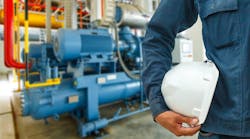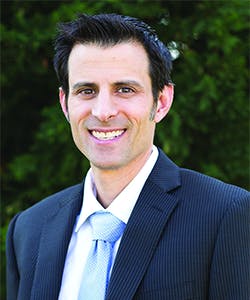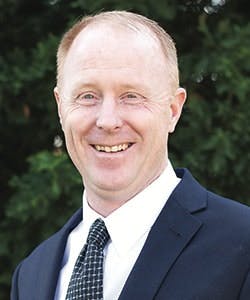Neil Mehltretter is technical director for Kaeser Compressors, and he has conducted and supervised thousands of industrial compressed air studies to help plant teams achieve significant energy savings and operational improvements. Bill Kemph is a project manager for engineering solutions for Kaeser Compressors and has more than 20 years of experience with building, testing, designing, and installing compressed air systems. In this episode of the Compressed Air Podcast series, Neil and Bill address the opportunities and challenges plants face when they consider alternative compressed air system design strategies.
PS: I'm looking forward to this topic, alternative design strategies. It's going to help our listeners think outside the box of ways to really improve the operation and design of their system. So, Bill, we'll start the series with a question for you if that's okay. What are some of the top benefits of moving the air, or, rather, moving the air system outside the plant?
BK: Tom, there's many benefits. They can range from freeing up plant space for other activities for production; removing sources of heat, noise, and getting those out of your plant; providing ease of access for service, which most people don't consider, while ensuring that the proper service clearances are maintained. Increasing security, that's a big point, with doing that, you know, technicians are no longer required to enter a plant. It often helps eliminate the need for any renovations for new construction in the case the plant has to expand or adapt to any new equipment that may take place. Depending on the plant, there could be many more.
PS: Neil, to follow up on that first question, do you think there's an advantage for some types of processes versus others to go with this route with their compressed air system? And I'm thinking of the old saying that every time you work on a piece of equipment, you have the potential to introduce defects. So, I'm struck by that.
NM: Sure, like Bill said in the first question, most folks start thinking about moving the compressors, or blowers, vacuum screws, boosters, whatever it may be, outside of the production floor for some specific reason, whether it be noise, whether it be safety, whether it be access. We've seen these types of enclosures go in food processing, distribution facilities are very big, breathing air applications, you know, maybe that's a mobile system where you have workers at various sites that are doing some kind of cleaning. Recycling facilities, or waste handling, those have become very big, from a standpoint of high dust debris inside that facility, that's really wreaking havoc on their rotating equipment now. And so, they're coming to us and saying, "What can we do?"
Neil Mehltretter
And we say, "Well, have you done this?" Yes. "Have you done this?" Yes. Okay, well, maybe we start introducing something different in the environment, somewhere we can control it. Metal fabricating is big, wastewater treatment facilities, even, as well, we've seen that with our rotary low blowers, or screw blowers, cement facilities too.
It really begs the question, "Why are we going to do this?" And most folks are looking at, "Can we make this system more reliable? Are we having ventilation problems right now? Is it an electrical feed issue where it might be easier if the equipment's outside closer to that feed?" So, we see the gambit and we can certainly support the gambit, but for me, reliability is probably the most paramount. And when we do or are able to move that rotating equipment outside of the facility, that really helps.
PS: It sounds like answering that question of "why" is a big part of the process that may lead to considering alternative design strategies, to break the mindset of “we do it because we do it.” Now, we're going to do something because it's the best thing for the plant.
NM: Absolutely. And what we find is, most folks have started to run out of space and they might be expanding, and say, "Well, where am I going to put this?" As an alternative to putting it in a closet or dare I say, in a bathroom – we've seen that too, where there's no windows and no doors, we talked about this, I think, last time too – it makes it a lot easier to, like you said at the outset, open your mind or think outside the box. And what's interesting is say, when you said that, keyed in on, let me think of a box, "What size box can I put this stuff in to make it reasonable?" And that does work.
PS: Well, that's a good segue to my next question, which I'm going to ask Bill about some of the more granular considerations for doing this kind of design. What are some of the biggest challenges that face plant teams when they want to do this, they want to put the air system outside the plant?
Bill Kemph
BK: You know, Tom, what I've seen as one of the bigger challenges is personnel acceptance. They're used to having things a certain way for many years and it's just hard for them to adapt and change. It takes all that additional effort to emphasize the benefits so they come to a understanding.
Another is the cost. Initially, they see the main dollar figure and it seems expensive. However, are they considering adapting new equipment into that old or existing facility? And then the margin starts to narrow.
PS: Interesting. Your point about the people aspect of this reminds me of many conferences that I've been to. I just returned from one last week in Clearwater, FL where the importance of doing the cultural work was really driven home. We even had an applied anthropologist give a presentation on doing a little bit of fieldwork into what habits people are into, and what habits they don't have, so that people introducing new ways of thinking and new systems can get those to be adopted more quickly.
NM: Yeah, it all has to be relatable. I find that fascinating in multiple tiers, and I have a follow-up question for you on this too. What I find really interesting in helping folks adapt is that data push. So, with whatever it might be – enclosure skid, container – we're building in a master controller in these systems so that we can push this data out, whether it be alarms, messages, warnings, or simple information on your compressed air equipment so that customers can see some things in real-time or get data in real-time.
You can do this with your existing equipment. It may be a little bit difficult if the equipment's antiquated, but for most installations with an individual control or a PLC-type controller, you can get this information out. And so, it's a great talking point to help people jump into that 21st Century because we all have phones, in some cases, we have multiple, and you constantly look at these things, whether you're walking or you're supposed to be listening to what someone else is saying. It's a great opportunity for us to really bring that compressed air system in real-time to that person.
And as a follow-up question to you, did you get to Frenchy's on Clearwater Beach?
PS: Yes, we did. Yes, we did. That was a great night. (laughs)
NM: There you go.
PS: It's a tight-knit community down there. It's really interesting, you've got the performers in every venue sort of doing their own thing. And yeah, it was beautiful too.
NM: Great. I'm glad you had a good week.
Listen to the entire interview
PS: Let me ask you a question about cost. Bill brought this up. So, how does the cost of doing things differently, moving the system outside the plant, compare to more traditional methods?
NM: To Bill's point, I think we kind of alluded to it a little earlier, but, in general, there's a shock factor when you look at an enclosure skid, container, whatever might be, and you see, oh, you know, the equipment is X, Y, Z, and when you look at it packaged, it might be double. And so, most folks think, "Yeah. Well, that's a stop measure right there. We can't move forward." And I'm not saying that's what it is, but you have to understand that a lot of that design and engineering is already into that and all that hardware. In most cases, like let's say, we're talking about a couple 25 horsepowers, most facilities would drop them in a room, hopefully put in necessary inlet louvers and an exhaust fan to bring that heat out, but, in general, a lot of folks overlook that.
And so, on the smaller systems, I would say, per capita, it's going to be certainly more expensive than, let's say, putting it in a room. But as you start to get into multiple compressors and we're talking 100 horsepower or 200 horsepower, that cost-benefit starts to push towards the enclosure. And what we do see in a lot of these cases, like I alluded to before, it's a footprint or it's a space situation, maybe it's, "We're selling this to a third party who's then making something else, so, it's part of their package," and all that's outside the compressor room.
So, when we talk about cost, it's if we were going to retrofit equipment into an existing space, what's it going to cost to demo that? If we have to bring new electrical, what's that going to cost? What's the cost of ventilation, new piping? And all that is going to be included in your enclosure, your skid container, etc. So, you're essentially paying for it, but it's usually from a different party, so, a third-party mechanical, something like this, whereas you're seeing all that upfront in your enclosure and maybe you get sticker shock.
Other things: if you could not fit it into the existing space, then what about building a new compressor room and what's it going to take to retrofit that? And then delivery times as well, to have somebody come out and construct it, there are going to be permits required and so on. When we talk about it, maybe we're talking about a little bit higher or a lot higher, depending on what size system you're looking at. So, again, if you're looking at several hundred horsepower, you're probably in a much better space than you are with the smaller systems, but again, what is it you're trying to gain from putting this in a separate space? So, great question.
PS: Bill, let me ask you a couple of engineering-type questions. Outside the plant location, there's lots of different environmental-climate differences between regions of the U.S., all over the world too, is there any limitation on the system when it comes to weather conditions, for example, extreme temperatures, high winds? And secondarily, could you talk a little bit about the size of the system too, whether there's any size constraints given out outdoors installations.
BK: There's many things out there that can affect the performance of the said package that we're talking about, and weather is one of the biggest factors that people overlook. This is why it's always important right from the get-go that we have a location for that site, we do an evaluation to know what's the heat load, how cold, how rainy, how dry. We have all those factors to play with when we're initially designing. The compressor itself is such a great benefit and resource that people overlook. I mean, you can utilize such aspects as the exhaust heat in those cold environments to reheat the room, to maintain that operating temperature in those real cold environments. And if you're dealing with the heat or a hot environment like Arizona, or New Mexico, or such, you can insulate the walls to abate those and retroact any kind of loading that you may have from the heat. So, there's a wide variety.
PS: What factor does size play when it comes to these systems? Is there a size limitation or can people sort of add on as they need to, as they go?
BK: The great thing about an enclosure is it's built from the ground up, so we can design them to accommodate a wide variety of equipment. The only real limitation that we have with an enclosure is that it can be...you know, we can transport it down the interstate, we can get it from point A to point B. Dependent on the size, it may become modular or multiple pieces and have to be put together on site. It can be planned ahead to have future expansion so that we can account for those growing businesses that need to look for the future. We can build that in, still make it all outdoors, not affect the main production, and keep the ball rolling, per se.
NM: Yeah, space is pretty paramount, and Bill totally touched on all these things. The limitation is transportation. You always get on the interstate and you're like, "Oh, I'm behind the wide load. Great. I'm not going to be able to pass." You know, we're not thinking about you as a driver, like, "Oh, we're very worried about you." We're thinking more about what's the cost to bring it from point A to point B, and how big or small can we make it? So, height restrictions are one thing, and then the width restriction, and then also the length. You're not going to see an enclosure that's complete that's going to be over 50 feet, that's not going to fit on a trailer, right? And we're also cognizant of height restrictions in various parts of the country, so we don't want to make it too tall.
These are things that we engineer into the package and consider. And you hit it on the head too, can we make it modular? Can we have one side open? And then you can put these things together on site. We've seen a lot of pod-type systems go in, so a customer says, "Ah, I need 1,000 cfm." So, we look at, "Okay. Well, here's an enclosure that has two 500 hp or 500 cfm compressors, and then here's another package that has two 500 cfm compressors. So, we can build in that redundancy." And we see that too, when customers start looking at buying air as a subscription, then this makes it a little bit easier also from a modular standpoint when customers are interested in paying for a cfm versus paying for capital cost.
PS: Neil, I know of Sigma Air Utility from discussions we've had before about solutions that plant teams can engage with when they're underhanded or understaffed through retirements, what have you. Can you talk a little bit about why Sigma Air Utility is, and how it factors into this conversation about alternative design strategies.
NM: Sure, Sigma Air Utility is Kaeser's branded name for compressed air that we sell direct to a customer. So, this allows customers to focus on their product – what they do very well – and allows Kaeser to be their provider. So, Kaeser owns the equipment, Kaeser services the equipment, so, that, you know, that pie chart, if you would, of capital cost and maintenance cost, that is something that you pay for monthly. Of course, customer pays for energy in that regard, and we're designing it to be as efficient as possible.
The great thing too is, I mentioned earlier about having that touchpoint, having data, and so, reporting features are part of that as well from a monthly standpoint on what your usage is and so on, and very helpful. This works well for customers who are looking to balance, let's say, cost of unit of production versus what their output is versus their input.
So, if it's a balance sheet-type thing, most customers think, "Okay. Well, if I can shift the focus to a different balance sheet on the cost of capital equipment, maybe that's going to help me out." Also, customers who may not have the cash on hand to make that capital cost, this might work well for them as well. We've seen it on Greenfield projects, meaning we're putting this new plan in and we're going to outsource the compressed air equipment to you. We've seen it replacing aged equipment.
It's also helpful when customers understand what their maintenance costs are. So, if they're putting a lot of money into aged equipment or if they need rental capacity at this time, the Sigma Utility looks a little bit more advantageous for them as well. As long as Kaeser knows what the flow pressure and air quality is and we have an idea on those ambient condition and the design requirements, it makes it easier to figure out what size system to do and the redundancy involved with that – whether compressors, dryers, filtration as well – it lends well to the alternative design strategy because it allows Kaeser to design the whole thing in our facility, and it's prepackaged. So, once it gets on site, really all you got to do is, you have to have the pad ready to go. You have to rig it into the point. Obviously, there's probably going to be tanks and you got to mount those things, but the amount of work that you have to do on site is limited, which most customers are pretty excited about because they want to pull that trigger and it's go time.



